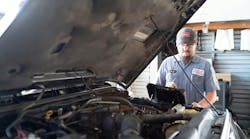We often get asked this age-old question: “Should I choose pneumatic or electric power tools?” Many users believe that one tool technology is best for everyone and every application. But that’s just not true.
Ultimately, it depends on the application (which could be bolting or removing material and could be in standard conditions or in a more challenging environment like shipyards or foundries), and what you’re trying to achieve. You can only make an informed decision once you have a full understanding of your tool’s requirements coupled with knowledge about the different technologies powering the tools – be it pneumatic or electric.
Each technology has its advantages and disadvantages, but before you decide which to use, first consider:
- What are you looking for in a tool? For example, is it power, efficiency, ergonomics, or freedom of movement?
- What is your working environment like? For instance, do you have a good quality airline set-up and the capacity to maintain it? Or do you only have access to electrical sockets? Are you working in environments where separate assessments need to be carried out, for example, a humid environment in the shipbuilding industry?
Selecting the right power tool
Once what you’re seeking is clear in your mind, then you can start looking at the benefits of each technology to see which one best fits your requirements. Here are the main advantages of each technology:
Corded electric
- Convenience: Electricity can be easily accessed in most workplaces, so it’s simple to plug in the tool and quickly get busy working.
- Procurement: These tools are readily available as they are sold by many vendors. There’s no need to go to a specialist.
- Cost: Comparatively speaking, electric tools are low cost.
Cordless electric tools (battery)
- Mobility: There are no power source constraints (as long as the battery is charged) – you can use the tool wherever and whenever it is needed. These tools provide excellent mobility and agility as there is no cord. They can easily be maneuvered in tight and difficult-to-access spaces.
- Autonomy: Cordless tools can have a good autonomy in everyday applications and for moderate use since today’s batteries last a long time between charges. Users don’t have to keep interrupting their work to change batteries. Battery technology is also improving all the time.
Pneumatic tools (air-powered)
- Ergonomics: These tools are lighter, more powerful, and deliver better ergonomics than electric tools.
- Cost: They provide lower maintenance costs
- Productivity: If well maintained and lubricated, pneumatic tools can be used continuously, 24/7.
Air vs. electric, what is best? Example with grinders
Let’s take a closer look at how you might choose a grinder. Grinders are commonplace in many industries, and electric (corded) and pneumatic tools are the most widely used. First, ask yourself the question, “Which key characteristics are important to me?”
If performance is vital for your application, then pneumatic grinders deliver the best results. They provide a better power-to-weight ratio and have a longer service interval, which contributes to an overall better performing tool.
However, if the initial purchase cost is your main priority, then an electric grinder is the best option as they are attractively priced.
An electric grinder is also a good option if there is no airline set-up available and compressed air is not easy to access at your worksite.
Buying the right tool for the job
Leading manufacturers continue to innovate and improve their tools every year, so technologies continue to advance. It’s worth seeking the advice of trusted experts and distributors to double-check that the tool you choose is the most appropriate for your application and will deliver on your expectations.
Information provided by Chicago Pneumatic


